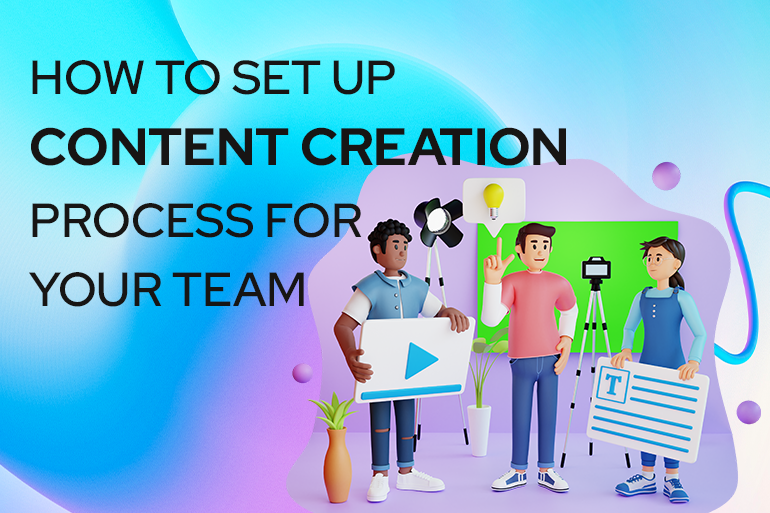Simply put, content creation is the process of planning and creating effective, useful, and accessible content that will play a vital role in attracting and keeping your audience engaged.
It is important to properly understand the content creation process in order to effectively reach your target audience as well as build a strong and trusted relationship with them.
Not only that, but content creation is one of the most inherent marketing practices. For any business and marketer, the customer is king. And therefore, attracting potential new customers and retaining existing customers is one of the highest priorities.
In addition to this, the right content creation process also helps to generate value for your company. While almost 40% of marketers say that content marketing is an important part of their marketing strategy, 81% admit that their company views content as a business strategy.
All that being said, creating content is not the easiest thing in the world. It can be quite challenging to develop content that will resonate and stay relevant to your audience. In fact, according to a Hubspot report, creating engaging content is one of the biggest challenges faced by content creators and marketers today.
To regularly create content that is high quality, consistent, and meets the needs of your target audience, setting up a good content creation process for your team is important.
Here are some steps that can be taken to set up a content creation process for the team:
- Define your goals and target audience
Defining your goals is essential to starting off the content creation process. Knowing your goals and who your target audience is will seriously help you move forward in your content creation process more efficiently. In order to create relevant, valuable, and inspiring content that also meets your business needs, this step is crucial.
- Create a strategy
At the very basic level, you must thoroughly brainstorm, develop ideas, have a look at your competitors, and so on. Some businesses hire or work with a content strategist for this. Creating a content strategy is important, as it will include a list of clear goals, a guide to brand style, a competitor analysis, an editorial calendar, and anything else that you or your content strategist thinks is necessary to shape the content creation process.
- Build a plan
Next up is to outline the kind of content you want to create and put out, the topics that will be covered, and how this content will be promoted and distributed. This is the step wherein the content manager works with the content strategist to make daily decisions about what, how, when, and why certain content must be written or created. It is necessary for the content manager to use SEO and keyword research to find topics and ways to improve traffic. Additionally, identifying topics that will work for different content formats is necessary.
Side Tip:
Creating a content calendar that will outline when and where content will be published. This will help you to stay organized and put out content consistently.
- Create content
Your content could include a wide variety of content types, including blogs, long-form videos, short-form videos, infographics, press releases, e-mails, e-books, and so on. Content creation is the main reason that you need to set up your content creation process in the first place. The type and quality of content being published and posted should meet certain standards that are decided by the content team and which align with the goals of the brand as well. Illusto is a great tool to help you on your content creation journey. It’s free, easy to use, DIY, and super fun!
- Assign roles and responsibilities
What goes hand-in-hand with content creation is the hand (or hands) behind the content. Content creators are the people who make everything come to life. You will either require specialists to work at each step of the process – including content writers, graphic designers, video producers, photographers, and so on, or one or two people who can work at multiple levels by themselves to create content.
These specialists can either work in-house or be outsourced. They can be divided into digital, communications and PR, and visual. The digital team is focused on writing blogs, scripts, e-books, and other informative content. The communications and PR team will stick to emails, press releases, sales material, and so on. Finally, the visual group, as the name suggests, will focus on images, videos, GIFs, and other visual elements required to make your content stand apart from the crowd and competition.
- Develop a style guide
A style guide is or rather should be an important component of any marketing strategy. It is a document that outlines and provides guidelines for how your brand should be presented from a linguistic and graphic perspective.
A style guide will outline the voice, tone, and style of your content and your brand. It helps to make sure that your content is consistent and reflects the true spirit of your brand.
- Review the content
Reviewing content is important, and this is one of the reasons why an editor is necessary. It is said that an editor can make a writer’s good work great. Different from a content manager, a content editor will strictly look at written content and similarly, an art director or coordinator will look at visual content, reviewing designs, photos, and so on.
At this stage, the person will look through the content and correct mistakes, suggest necessary revisions, and do the job of a coach. For instance, if a writer is struggling with a certain piece, an editor might be able to give suggestions and offer guidance to move ahead.
- Promote your content
It is always a good idea to have a person who is responsible for posting, publishing, and pushing out content on the web. A digital marketing specialist is usually the one appointed to fulfill this role. After publishing, when your content is live, the marketing team should keep a promotion strategy in place. This might include the paid, earned, shared, and owned aspects of the content – also known as the PESO model.
Sponsored ads, social media posts promotion, and so on fall under paid. Media pitches would fall under earned, responding to messages, comments, and so on would be shared, and anything originally produced by the brand like blogs, websites, newsletters, and so on come under owned content.
Pro Tip:
Researching and using the latest tools and technologies to broaden your horizons and help your content creation process is key.
- Measure and evaluate results and data
Once your content is published, it is important to measure, analyze and evaluate its performance. This will help you to identify and understand what works and what needs improvement. Measuring your content is seen to be most effective when it’s designated to those who will use the results to change up or improve your content strategy. Either the content strategist or a content analyst will do this job effectively.
This part affects everyone on the team and will heavily impact what content you create, push out, promote, and so on.
Even if you have a small content team, it is always important to think about these levels involved in content creation in order to come up with adequate measures and effective content that will help you bring in more customers and sustain existing ones, all while building your brand.










